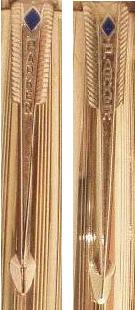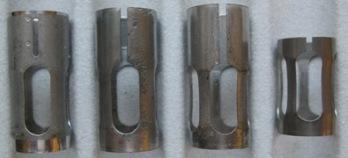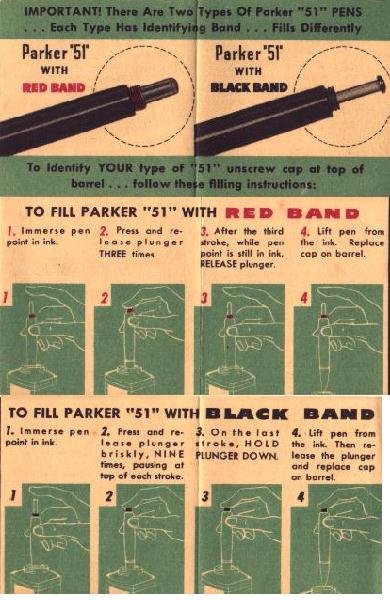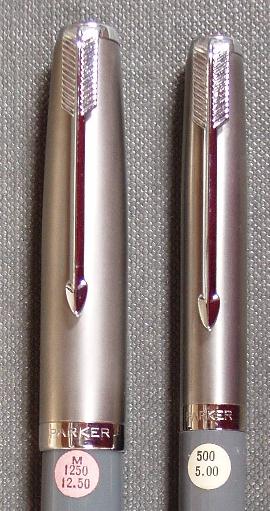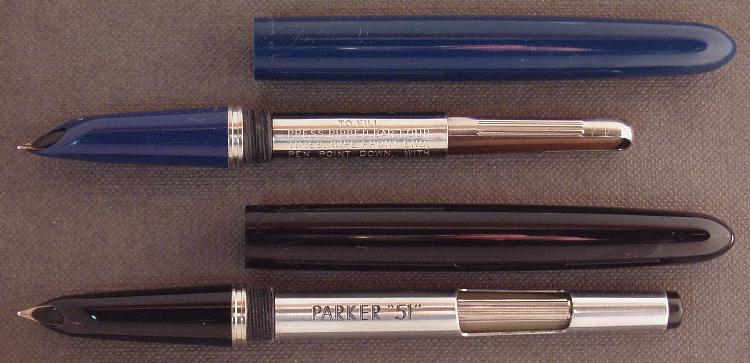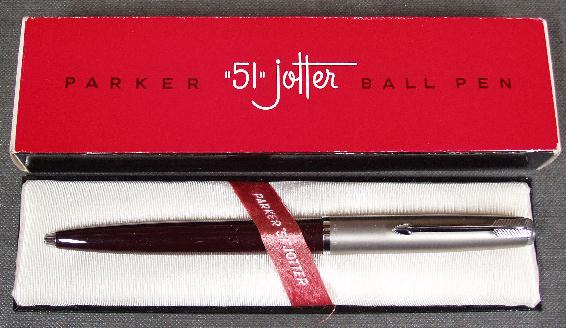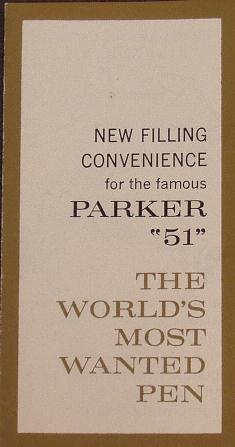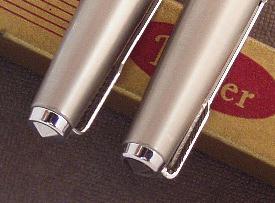“Like a pen from another planet”……..”So unique and so beautiful there is nothing to compare to it–so good it cannot be improved by any known method!”
| Parker “51” Vacumatic Filler “First Year” 1940-1941 |
The Parker “51” commonly referred to as a “First Year” pen is really a pen from late 1940 through 1941. They can be easily distinguished from later production by several unique characteristics. Practically all pens of this period are double jewels, meaning that they have a decorative “jewel” at the top of the cap and at the end of the barrel (a handful of single jewel pens dated 4th quarter 1941 with imprints by the clutch ring have been found). The imprint on the majority of these pens is at the end of the barrel, near the decorative “jewel”, all in one line.
Parker “51” Made in USA .1.
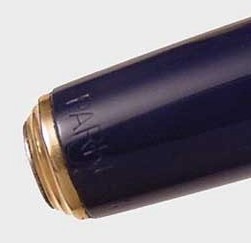
They may or may not have a “1” datecode after the imprint. Some collectors speculate that the ones without a datecode are really pre-production models from 1940. Another explanation may be that they were never dated or that the datecode wore off (on most instances the datecode is lightly imprinted to begin with). It should be noted that some double jewel examples have been found with the imprint up by the clutch ring, with a datecode of “1”. In addition, I have been able to inspect a demonstrator with the “1” imprint by the clutch ring and a rounded blindcap.
In addition, in most, but not all cases, the “first year” pens will have jewels made of aluminum. 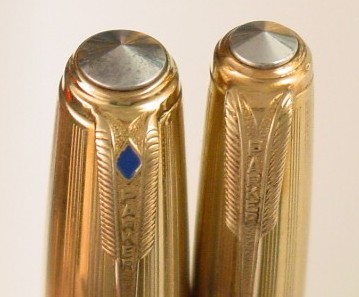 Some collectors will assume that a “first year” pen without the aluminum jewels is not correct. This is not the case. One does find with regularity “first year” pens with plastic jewels. It is also rather common to find “first year” pens with just a barrel aluminum jewel and a plastic cap jewel. It seems as it Parker ran out of cap jewels first, and continued production with whatever was available. On some pens, Parker also appears to have used sterling silver for the jewels, as one does find “first year” pens with jewels that have that unmistaken yellowish silver patina or heavy tarnish. Most likely this was due to the pre-war constraints on strategic materials. It should be noted that aluminum jewels can look very different depending on wear and age. New Old Stock pens have aluminum jewels that will show machining lines. As they wore, due to the softness of the material, they became shiny and lost most of the machining lines. They jewels do dent easily and can get corroded and pitted.
Some collectors will assume that a “first year” pen without the aluminum jewels is not correct. This is not the case. One does find with regularity “first year” pens with plastic jewels. It is also rather common to find “first year” pens with just a barrel aluminum jewel and a plastic cap jewel. It seems as it Parker ran out of cap jewels first, and continued production with whatever was available. On some pens, Parker also appears to have used sterling silver for the jewels, as one does find “first year” pens with jewels that have that unmistaken yellowish silver patina or heavy tarnish. Most likely this was due to the pre-war constraints on strategic materials. It should be noted that aluminum jewels can look very different depending on wear and age. New Old Stock pens have aluminum jewels that will show machining lines. As they wore, due to the softness of the material, they became shiny and lost most of the machining lines. They jewels do dent easily and can get corroded and pitted.
The clips on “first year” pens are also rather unique. They actually resemble the Parker Vacumatic clips in use at the time. The blue diamond is larger than the later clips, and the enamel used is of a lighter blue color. In addition, the clips are plated over a brass base and are die struck, resulting in a negative image on the back.
Another identification aid can be the filler unit. In most examples, the filler will be the standard aluminum speedline filler used on the Vacumatic line of the time, although not all “first year”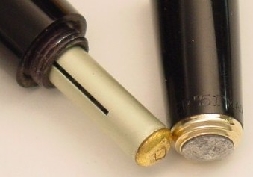 examples have the speedline aluminum filler. New Old Stock examples can be found with correct plastic filler, and some may have been switched as the result of a repair. Interestingly, some of the 1942 production pens are found with aluminum speedline fillers. On very early examples, the filler will not have the diamond struck at the end of the brass button.
examples have the speedline aluminum filler. New Old Stock examples can be found with correct plastic filler, and some may have been switched as the result of a repair. Interestingly, some of the 1942 production pens are found with aluminum speedline fillers. On very early examples, the filler will not have the diamond struck at the end of the brass button.
The nib is also different in the “first year” pens. It is completely devoid of any markings. Parker did not start marking and dating the nibs until 1943. It should be noted that dating a pen by the nib can be very innacurate, as it is the most often replaced part on a pen.
Other ways of identifying correct “first year” pens can be gained with years of experience of looking at examples; the hoods are of slightly different and unique shape; the caps are unique to the era (see the “Caps” page); the clutch inside the caps is longer than later ones and the very early caps have 4 “portholes” instead of the more common 5 “portholes”. The shade of colors of “first year” pens tend to be different. Overall, in order to correctly identify a “first year” pen you need to look at the whole pen and not just one single characteristic. One well known collector once said to me “there are more so called “first year” pens out there than Parker ever made”.
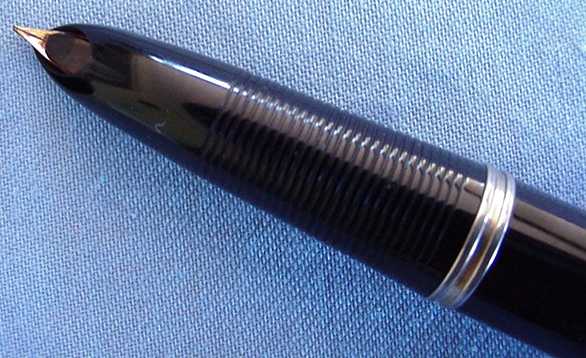
The picture to the left shows an early “First Year” pen with a ribbed hood, similar to the pattern found on the pencils. I have only seen 2 such pens, the second one dated 1944 and on a cordovan barrel, which has the tell-tale Parker-font factory engraved name on the barrel. Probably an experiment by Parker, maybe given to employees to test.
| Parker “51” Vacumatic Filler Blue Diamond Clip 1942-1947 |
Starting in 1942, all Parker “51” pens had the imprint up under the barrel clutch ring. During the first quarter and part of the second quarter of 1942, the imprint remained all in one line, just as the 1941 pens;
Parker “51” Made in USA .2.
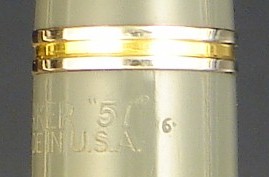
Some of these pens will incorporate early production materials, such as the caps and speedline filler. Sometime in the second quarter of 1942 the imprint was changed to the standard two line format that remained in place until the end of the “51” vacumatic production in 1948. Dating of Parker “51” pens is easy, down to the quarter it was made; at least for the barrel. Parker used a date system of one digit, surrounded by a series of dots to signify the quarter the pen was made in. The year was started with three dots and as the year progressed, a dot was ground-off the die, as follows;
| First Quarter | 3 dots |
| Second Quarter | 2 dots |
| Third Quarter | 1 dot |
| Fourth Quarter | no dots |
Some of the early caps carried over into the later production, but all now had the metal content down by the cap band. Some of the war year clips show a silver base instead of brass, and seem to be extruded instead of struck, were you no longer see a negative image on the back of the clip. Later production again returned to a brass base. The blue diamond color is also a darker blue and smaller in size. The blue diamond clip was discontinued in mid 1947 due to a ruling by the FTC against lifetime warranties, but was probably fitted to later pens as supplies allowed. Curiously, some Parker “51” ads of mid-1947 depict the Blue Diamond style clip with the blue diamond airbrushed out. In addition, one frequently finds Blue Diamond clips of the era with no traces what-so-ever of blue enamel in the diamond area. I speculate that Parker did sell some Blue Diamond clip pens without the blue painted in during the transition period to the plain arrow clip.
The nibs are all dated starting with 1943, and most will have the tipping material also engraved on the nib. The earliest 1943 nibs will have OS-PL, which stands for Osmiridium Plathenium, changed later in the same year to RU-PL, which stands for Ruthinium Plathenium. Sometime in 1947, the designation was changed to just RU. The RU designation continued on nibs through 1950. Starting in 1951, the tipping designation on the nibs was again changed to PU. Nibs were available in a very wide range of point sizes. Click here to see a detailed chart of the point sizes available from Parker for the “51”.
Pens were available in a variety of colors, in both single and double jewel models (see “Colors” page for chart of colors), in order or rarity;
| Midnight Black |
| Dove Gray |
| Cedar Blue |
| Cordovan Brown |
| Buckskin Beige |
| Yellowstone Yellow |
| Nassau Green |
In the case of Midnight Black, Dove Gray, Cedar Blue, and Cordovan Brown, the double jewel models are more desirable than the single jewel models. In the case of Buckskin Beige, Yellowstone Yellow, and Nassau Green, the single jewel models are actually much rarer. This could be due to the fact that according to Parker internal literature of the time, the single jewel models of Buckskin Beige, Yellowstone Yellow, and Nassau Green were available for export only. Of the single jewel models, the Buckskin Beige version is by far the hardest to locate.
| Parker “51” Red Band Filler 1946-1947 |
From the beginning of production, Parker struggled with the problem of flooding collectors on the Parker “51” and experimented with various different filling systems. One of these filling systems was the short lived “red band filler”. It was filled via a button at the end of the short barrel blindcap, encased by red threads made of either plastic (early) or aluminum (later). The filler was essentially a standard button filler, modified for the “51” with a special sac designed of a composite material. It did go into production for a short time, but proved very difficult to repair and was withdrawn from the marketplace, to be replaced by the aerometric filler in 1948.
photo by David Isaacson
Most of the pens found with the “red band filler” are deskpens, all in black. Pocket versions are also found, with black being the most common. Other colors are very hard to locate, and so far I have only seen a handful in gray and cedar blue. In addition, not all pens are imprinted. Actually, less than half of the pens seem to have any markings at all, and those that do, all have a 1946 datecode. To learn more about this unique filler, please see the comprehensive article on the Pennant by Don Hiscock, Dan Zazove and Michael Fultz.
| Parker “51” Vacumatic Filler Plain Arrow Clip 1947-1948 |
In mid 1947 Parker discontinued the Blue Diamond guarantee due to an FTC ruling against lifetime warranties. With this ruling Parker redesigned the “51” to closely resemble the first arrow clips on the Vacumatic pens. The caps were also changed, where in all instances the word “Parker” was added to the cap band. Some of the cap patterns from the Blue Diamond era carried over, and some brand new patterns were created (see the “Caps” page for details). All pens were still available as single or double jewel, in the same range of colors. It must be note that although a Blue Diamond cap is technically not correct on a late 1947 or 1948 pen, one does find plenty of pens with this combination. This is no doubt the result of Parker and dealers accomodating customer’s preferences from stock at hand. In addition, over the years, a pen such as the Parker “51” with easily interchangeable caps and collectible, will end up with a wide variation of switched caps.
| Parker “51” Demi-sized Vacumatic Filler Plain Arrow Clip 1947-1948 |
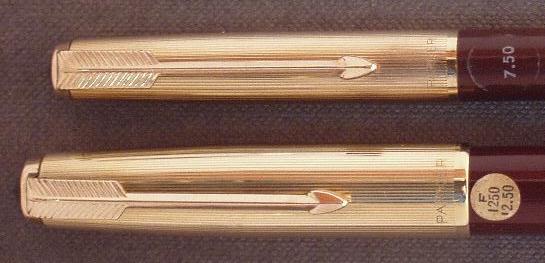 In 1947, Parker came out with a new “51” vacumatic model, the Demi-Sized model. This pen was much shorter than a regular “51”, and was advertised for women. The only difference really was in the barrel of the pen, in that it was of a shorter length. Other than that, all other components were identical to a regular “51”, using the same hood, collector, nib and blindcap. One noticeable change was the unique sized cap
In 1947, Parker came out with a new “51” vacumatic model, the Demi-Sized model. This pen was much shorter than a regular “51”, and was advertised for women. The only difference really was in the barrel of the pen, in that it was of a shorter length. Other than that, all other components were identical to a regular “51”, using the same hood, collector, nib and blindcap. One noticeable change was the unique sized cap 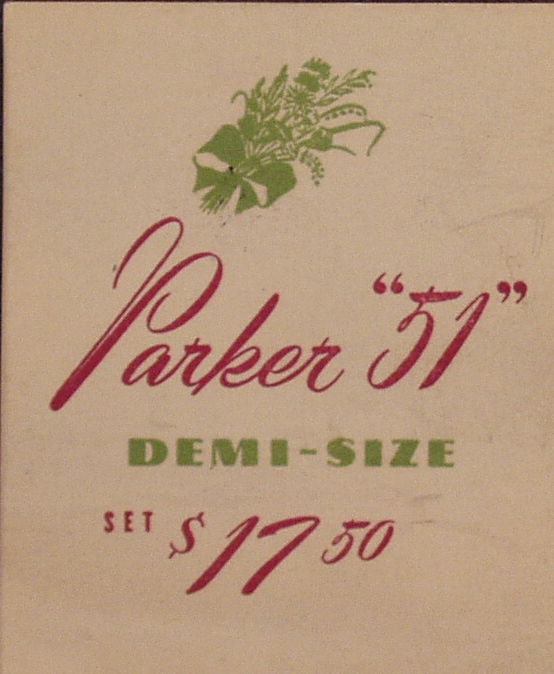 designed for the Demi. Although identical in diameter, it was shorter, giving the pen a much better balanced look. Only two cap patterns were available for the Demi, as seen on the “Caps” page, one in Lustraloy and one in Gold Filled. It should be noted that one can often find Demi “51”s with a regular size or even regular sized “51”s with a Demi cap, not an original combination, and most likely a result of a later switch. Visually these pens will not look right, although the caps do fit. Production continued through 1948.
designed for the Demi. Although identical in diameter, it was shorter, giving the pen a much better balanced look. Only two cap patterns were available for the Demi, as seen on the “Caps” page, one in Lustraloy and one in Gold Filled. It should be noted that one can often find Demi “51”s with a regular size or even regular sized “51”s with a Demi cap, not an original combination, and most likely a result of a later switch. Visually these pens will not look right, although the caps do fit. Production continued through 1948.
| Parker “51” Aerometric Filler 1948-1969 |
In 1948, Parker introduced its redesigned Parker “51” with its new “Foto-fill Filler”, later renamed to the “Aero-metric Filler”. It announced a series of 15 different improvements, including the capability to be carried at high altitudes. The filler was now a sac made out of “Pli-glass”, advertised to last at least 30 years. These sacs are still going strong after almost 60 years and one seldom finds a bad one. The “pli-glass” sac was inside the removable barrel and was protected by a metal sleeve. In 1948, the first filler sleeves were made of aluminum and switched to chrome plated in 1949, then brushed stainless steel by 1950. New models included an all gold filled cap and barrel, known as the Signet, launched in 1948, followed by the all lustraloy cap and barrel Flighter, a solid 14k gold cap and barrel Presidential in 1949 and a new Demi sized pen, available in all the finishes of its bigger sized brother, including the 14k caps. Of the three all-metal models, only the Signet was available in Full and Demi sizes.
From 1948 to 1950, the caps had a long arrow clip, but in 1951 it was changed to the short arrow clip, similar to that used in all the demi pens. This continued until the end of production for this model in 1969. Also, the early pens had a choice of a gold filled clip on a Lustraloy cap, an option discontinued by 1950. There were various cap choices available, although not as varied as the earlier Blue Diamond style caps, including Lustraloy, Gold Filled and Solid 14k gold, detailed in the “Caps” page of this website. The sterling silver caps were dropped in the aerometric series. A new range of colors was developed for the Aerometric “51”s as follows, in order of rarity:
| Black |
| Navy Blue |
| Grey |
| Burgundy |
| Teal |
| Forest Green |
| Cocoa |
| Plum |
The imprint on the pens was changed by removing the Parker “51” portion and only leaving “Made in USA”, dated with a single digit in 1948 or 1949, and switched to a new two digit code in 1950 (although I have found a New Old Stock aerometric pen dated 1948 with the standard 2 line vacumatic imprint). In contrast, the pencils were imprinted with “Parker 51 Made in USA”. The latest pen example with a date code I have found is 1952, and the latest pencil is dated 1956. Some dating aides can be found under the Parker “51” Chronology page. In 1950, Parker introduced the “51 Special”, a lower price alternative pen, with a steel nib and shiny polished cap with a black jewel. The “51 Special” can be found in all the standard aerometric colors, except Plum.
A smaller Demi pen was available from the beginning of the aerometric production. This was a Parker “51” pen in all respects, similar to the Full size aerometric version, but with smaller proportional dimensions. It should be noter that the cap of the aerometric demi will not fit any other “51”. The last aerometric demi was made in 1960, and I have found one with the breather hole moved to the side of the barrel, a change that took place around the same time. The “51 Special” was also available as a Demi. In the first years, 1948-1949, the filler was fully covered as in the full size version. Beginning in 1950, the filler cover was changed to an “open” style, as illustrated below. This was very similar to the “51 Special”.
| Parker “51” Jotter 1954-1969 |
In 1954, Parker introduced its famed Jotter Ballpoint. In the same year, Parker introduced a matching “51” Jotter. The Jotters were available in all of the same colors as the fountain pens, with the exception of Plum (remember that Plum was discontinued in 1949). The were available with either a Lustraloy cap or a Gold Filled cap with converging lines only. The 14k solid gold caps did not carry to the ballpoints. Early production “51” Jotters have metal threads, making them heavier and heftier. These early production versions are more desirable than the later all plastic barrel production pieces.
| Parker “51” Converter 1961-1963 |


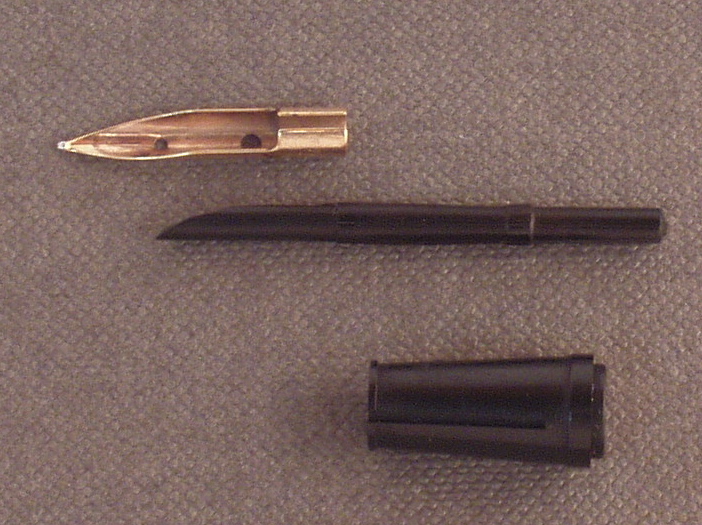
In 1961, Parker tried to capitalize on the success of their new convertible Parker 45 introduced the previous year. Essentially a “51” in most respects, with the exception that instead of a built-in filler, it now had the capability of using either a converter or cartridges and for the first time its famed finned collector was changed, as illustrated in the picture above. The collector was no longer finned and seemed not to serve any purpose other than holding the redesigned feed. The pen had a unique connector ring/nipple, sometimes confused by the inexperienced collector for a broken aerometric filler. The barrel is also unique, in that it has no breather holes and is cut shallower and narrower inside and will not fill a regular full-sized aerometric pen. Although advertised as more convenient, the success of this pen was limited, and it was discontinued late in 1963. The reason for the limited success has been speculated to be that the cartridge gave the new “51” an image of being disposable, something that had not been part of the “51” positioning over the previous 20 years of production or maybe the redesigned collector affected performance more than expected. Examples have been found in black, gray, navy blue, teal, burgundy and forest green.
| Parker “51” Aerometric MKIII 1969-1972 |
Around 1969, near the end of its life, Parker redesigned the “51” one last time, often called the MKIII. This time the cap was completely changed to closely resemble the Parker 61, and the barrel now had a flat end. The cap had a “51” inscribed on it twice, opposite from each other. The clutch ring became a thin decorative piece with no use, as the cap was fitted with a finger clutch that grabbed onto the hood. The plastic used for the barrel was changed to a softer variety, and as a result will easily deform around the hood from the pressure of the finger clutch inside the cap. Two more colors were introduced with the series, advertised as Rage Red and Vista Blue (Rage red is illustrated below). Rage Red is the hardest color to come by of the later MKIII Parker “51”s. Other colors found are Gray (same as the 61), burgundy, navy, black and blue-gray (same as the earlier “51” color).
The first so called MKIII pens had a traditional pearl jewel on the cap. Around 1973, the clip was redesign to have an integral metal jewel due to federal government regulations (Parker Parts Catalog 9/73). No detail is given of why the new regulation came into effect, but it probably had to do with the danger of swallowing the small parts by children, as this is the era that this type of regulations started to be common place. The latest packaging instructions that I have seen for the MKIII are dated June 1972, but I have seen Parker advertising for the MKIII as late as 1976. Production of the MKIII Parker “51” continued in England well after it was discontinued in the U.S.
